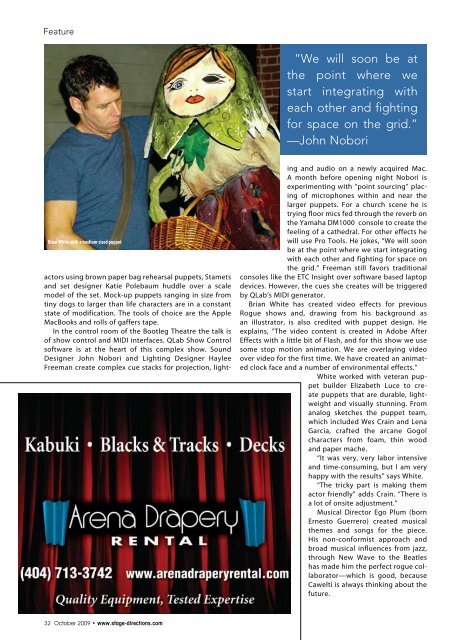Download a PDF - Stage Directions Magazine
Download a PDF - Stage Directions Magazine
Download a PDF - Stage Directions Magazine
You also want an ePaper? Increase the reach of your titles
YUMPU automatically turns print PDFs into web optimized ePapers that Google loves.
Feature<br />
“We will soon be at<br />
the point where we<br />
start integrating with<br />
each other and fighting<br />
for space on the grid.”<br />
—John Nobori<br />
Brian White with a medium-sized puppet<br />
actors using brown paper bag rehearsal puppets, Stamets<br />
and set designer Katie Polebaum huddle over a scale<br />
model of the set. Mock-up puppets ranging in size from<br />
tiny dogs to larger than life characters are in a constant<br />
state of modification. The tools of choice are the Apple<br />
MacBooks and rolls of gaffers tape.<br />
In the control room of the Bootleg Theatre the talk is<br />
of show control and MIDI interfaces. QLab Show Control<br />
software is at the heart of this complex show. Sound<br />
Designer John Nobori and Lighting Designer Haylee<br />
Freeman create complex cue stacks for projection, lighting<br />
and audio on a newly acquired Mac.<br />
A month before opening night Nobori is<br />
experimenting with “point sourcing” placing<br />
of microphones within and near the<br />
larger puppets. For a church scene he is<br />
trying floor mics fed through the reverb on<br />
the Yamaha DM1000 console to create the<br />
feeling of a cathedral. For other effects he<br />
will use Pro Tools. He jokes, “We will soon<br />
be at the point where we start integrating<br />
with each other and fighting for space on<br />
the grid.” Freeman still favors traditional<br />
consoles like the ETC Insight over software based laptop<br />
devices. However, the cues she creates will be triggered<br />
by QLab’s MIDI generator.<br />
Brian White has created video effects for previous<br />
Rogue shows and, drawing from his background as<br />
an illustrator, is also credited with puppet design. He<br />
explains, ”The video content is created in Adobe After<br />
Effects with a little bit of Flash, and for this show we use<br />
some stop motion animation. We are overlaying video<br />
over video for the first time. We have created an animated<br />
clock face and a number of environmental effects.”<br />
White worked with veteran puppet<br />
builder Elizabeth Luce to create<br />
puppets that are durable, lightweight<br />
and visually stunning. From<br />
analog sketches the puppet team,<br />
which included Wes Crain and Lena<br />
Garcia, crafted the arcane Gogol<br />
characters from foam, thin wood<br />
and paper mache.<br />
“It was very, very labor intensive<br />
and time-consuming, but I am very<br />
happy with the results” says White.<br />
“The tricky part is making them<br />
actor friendly” adds Crain. “There is<br />
a lot of onsite adjustment.”<br />
Musical Director Ego Plum (born<br />
Ernesto Guerrero) created musical<br />
themes and songs for the piece.<br />
His non-conformist approach and<br />
broad musical influences from jazz,<br />
through New Wave to the Beatles<br />
has made him the perfect rogue collaborator—which<br />
is good, because<br />
Cawelti is always thinking about the<br />
future.<br />
32 October 2009 • www.stage-directions.com

















